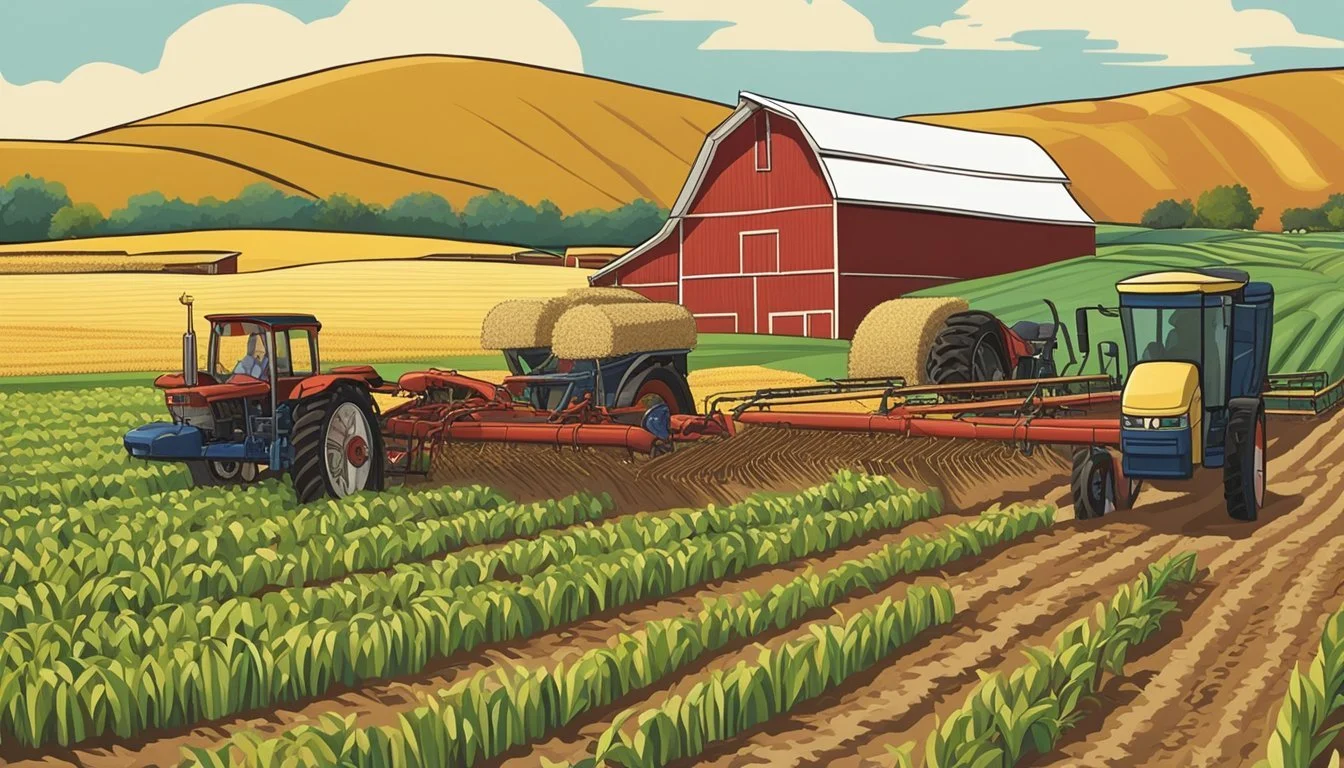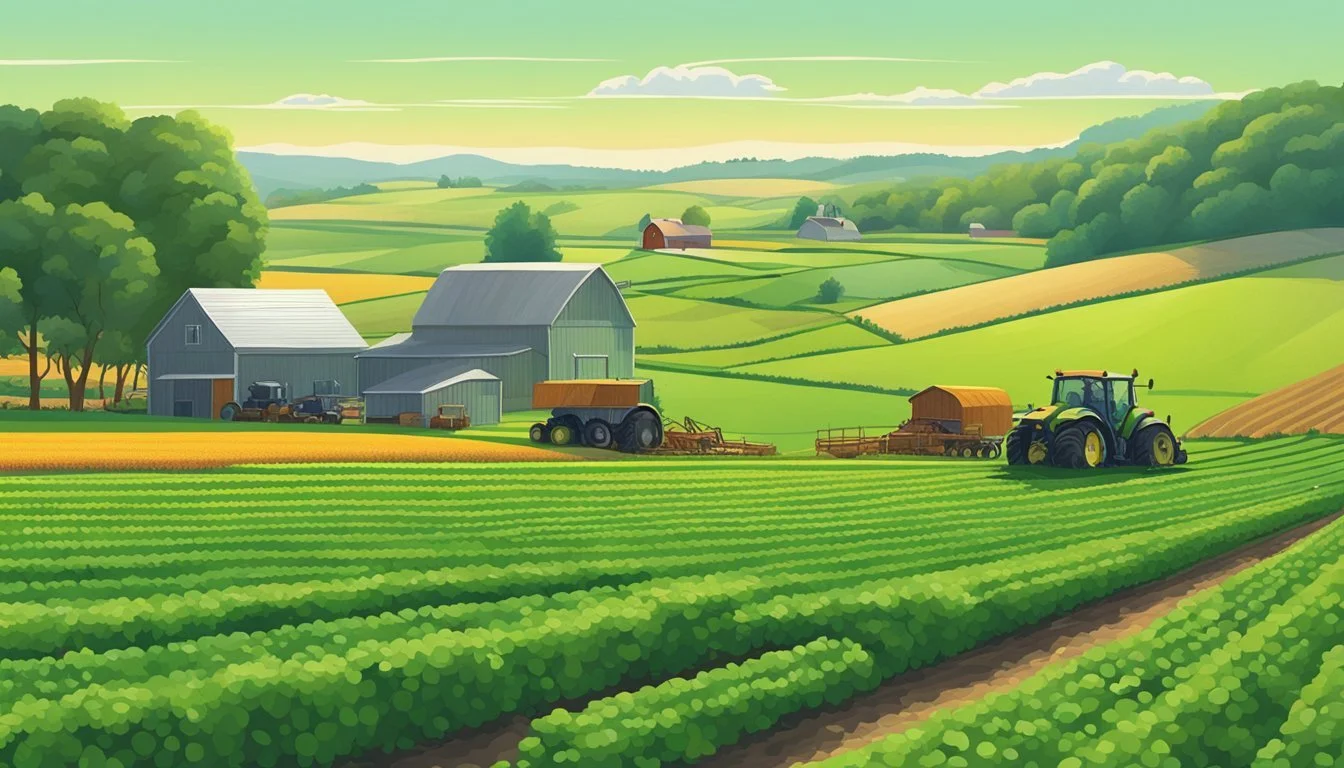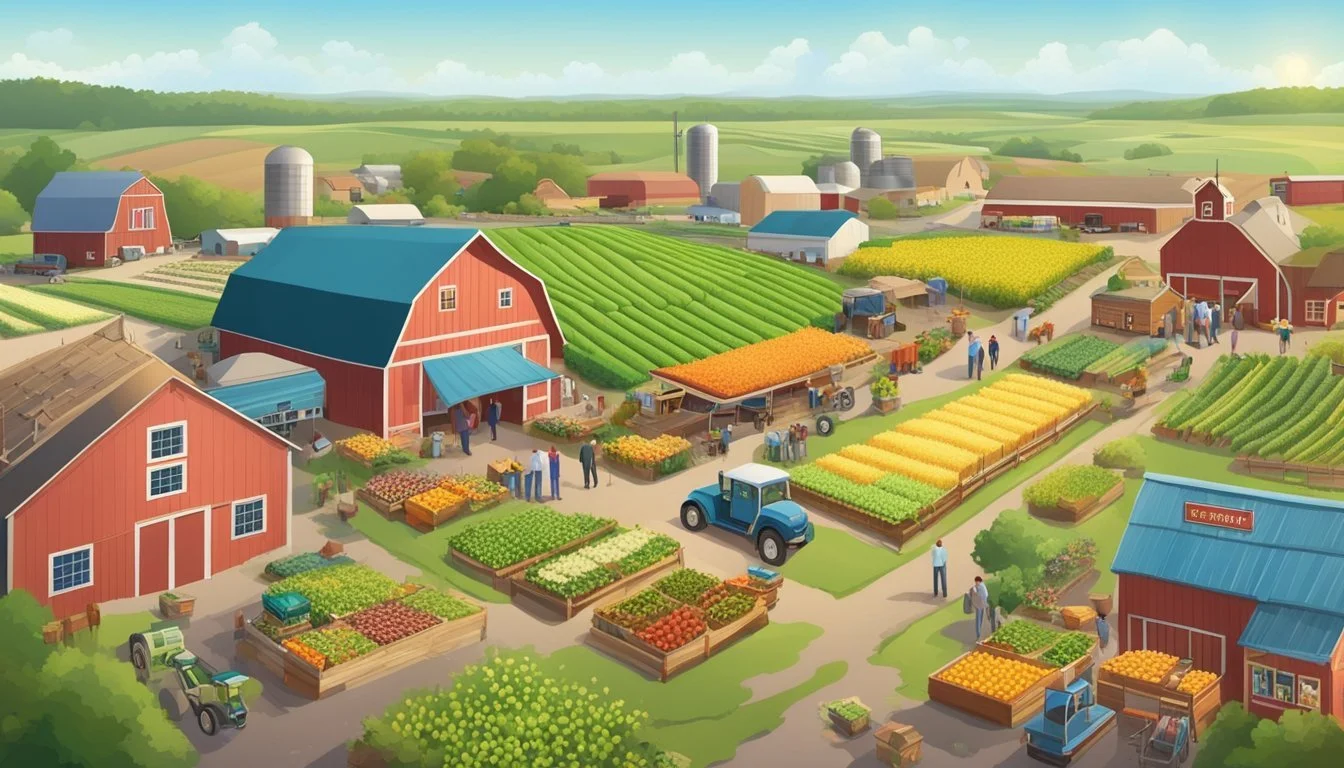Farming Communities in Nebraska
Sustaining Tradition and Embracing Innovation
Farming communities in Nebraska represent both the state's rich agricultural heritage and its vibrant rural life. Nebraska's fertile lands and favorable climate conditions make it an ideal location for various types of farming, from vast corn and soybean fields to livestock ranching. With nearly 200,000 acres of farmland recently listed for sale, the economic impact on local communities is substantial, driving not only agricultural production but also local commerce and social structures.
The state's farming towns, such as those in Hitchcock County, offer crucial insights into rural American life. These areas often blend traditional farming practices with modern agricultural technology, showcasing a unique synergy between history and innovation. Small towns like Hay Springs and Ainsworth, known for specific farms and ranches, provide an authentic experience of Nebraska's rural lifestyle.
The cultural significance of these communities goes beyond farming. Residents of these areas often enjoy a close-knit communal atmosphere, where shared agricultural activities foster strong bonds among neighbors. The social fabric of these communities is woven with shared experiences that reflect a deep connection to the land and a collective approach to challenges and successes in farming.
History and Culture of Farming in Nebraska
Nebraska's farming communities have deep roots, reflecting a rich agricultural heritage and evolving traditions. The history of farming here is closely intertwined with the economy and way of life of Nebraskans.
Agricultural Heritage and the Cornhusker State
Nebraska's identity as the Cornhusker State underscores its pivotal role in American agriculture. Family farms dominate the landscape, maintaining traditions passed down through generations.
Many Nebraska farms have been family-owned for decades. This continuity has fostered a stable agricultural environment. Notably, by 2018, the state had around 45,901 farms, crucial to its economic stability.
Agriculture in Nebraska began with Native American tribes, who practiced farming with bone and stone tools. European settlers advanced these practices, transforming the region from wilderness to farmland. Sod corn, flax, and forage were among the initial crops grown, reflecting the state’s fertile soil.
Tradition and the Evolution of Farming Communities
The transition from indigenous farming methods to modern agriculture was marked by significant developments. The introduction of bows and arrows and bone tools exemplifies early innovation.
The Homestead Act of 1862 played a crucial role. Daniel Freeman’s claim in Nebraska in 1863 symbolizes the start of extensive European settlement. The evolving farming techniques led to a thriving rural society post-Civil War.
These farming communities have preserved a unique way of life. Nebraska farmers and ranchers have adapted to technological advances while maintaining core traditions. Community events, agricultural fairs, and cooperative farming highlight their commitment to both innovation and tradition. The convergence of history and modernity defines Nebraska's enduring farming culture.
Geography and Climate Impact on Agriculture
Nebraska's diverse geography and varying climate patterns play a critical role in shaping agricultural outcomes. Specific factors such as soil health, local variations, climate conditions, and precipitation patterns directly influence farming productivity.
Soil Health and Local Variations
Nebraska features a range of soil types that vary significantly across different regions. In the eastern part of the state, near Lincoln, the soils tend to be loamy and fertile, supporting robust crop yields. In contrast, the western regions, bordering South Dakota, have sandier soils, which can be more challenging for crop production.
Soil health impacts the ability to retain moisture and nutrients, which is crucial for crop growth. Conservation practices like crop rotation and cover cropping help maintain and improve soil quality. Additionally, the adoption of precision agriculture techniques allows farmers to manage soil health at a micro-level, enhancing overall productivity.
Climate Patterns and Precipitation
Nebraska exhibits marked climate variations, which affect farming practices significantly. The eastern part of the state receives more consistent rainfall, beneficial for crops like corn and soybeans. Precipitation levels drop substantially as one moves westward, requiring more reliance on irrigation systems.
Weather patterns caused by climate change are altering these traditional precipitation dynamics. Increased temperatures and sporadic rainfall events can lead to both droughts and floods. Such extremes pose challenges for agricultural producers in maintaining stable yields.
The University of Nebraska-Lincoln studies indicate a 25% fluctuation in crop yields due to climate shifts between 1968 and 2013. These findings underscore the need for adaptive strategies to mitigate the effects of climate variability on agriculture.
Economic Impact of Agriculture in Nebraska
Agriculture plays a crucial role in Nebraska's economy, driving financial stability and employment across the state. This section explores how different agricultural activities, such as crop and livestock production and ethanol manufacturing, contribute significantly to the economic landscape.
Contribution of Crops and Livestock to the Economy
Nebraska's agricultural sector generates significant revenue through crop and livestock production. Corn and soybeans are the primary crops, with Nebraska farmers planting 10.1 million acres of corn in 2024. This large-scale farming results in substantial economic returns and employment opportunities.
Livestock farming also plays a vital role. Cattle, hogs, and poultry farming contribute billions annually. This sector supports not only farmers but also industries like meat processing, feed supply, and transportation. In essence, both crop and livestock sectors are cornerstones of Nebraska's economic stability.
Ethanol Production and Its Economic Significance
Ethanol production is another key factor in Nebraska’s agricultural economy. The state leverages its abundant corn supply, with 96% of the corn acreage planted with biotechnology varieties, to produce ethanol. This biofuel industry reduces oil imports and enhances trade balance.
Economically, ethanol production provides jobs in rural areas and adds value to agricultural outputs, particularly corn. Ethanol plants create direct employment and further stimulate local economies by increasing demand for farm products and services. This sector is essential for both the energy and agricultural economies in Nebraska.
Current Agricultural Practices
Farmers in Nebraska have adopted various modern techniques to enhance productivity and sustainability. Key strategies include crop rotation for soil health and precision agriculture for optimized resource use.
Crop Rotation and Soil Conservation Techniques
Nebraska farmers utilize crop rotation to maintain soil fertility and reduce pest issues. Common rotations involve alternating between corn, soybeans, and wheat. This method helps break pest cycles and prevent soil nutrient depletion.
Implementing cover crops like clover and rye helps prevent erosion and increases organic matter. No-till farming is another essential practice, reducing soil disruption and enhancing water retention. These combined techniques play a crucial role in sustainable agriculture, aiding in long-term soil conservation and productivity.
Precision Agriculture and Use of Technology
The integration of precision agriculture significantly enhances efficiency in Nebraska's farms. Technologies such as GPS-guided tractors and drones for monitoring crops allow precise application of water, fertilizers, and pesticides. This targeted approach reduces resource wastage and lowers environmental impact.
Soil sensors and data analytics provide real-time insights into soil moisture and nutrient levels, enabling farmers to make informed decisions. These advancements contribute to higher yields and resource optimization, ensuring that modern Nebraska farms remain competitive and sustainable.
Environmental and Sustainability Considerations
Farming communities in Nebraska are embracing sustainable practices and organic farming to enhance environmental health and agricultural productivity. These practices help maintain clean water sources, improve soil fertility, and reduce carbon footprints.
Sustainable Practices and Organic Farming
Nebraska farmers are increasingly adopting sustainable practices to ensure long-term soil health and environmental conservation. Techniques such as crop rotation and cover cropping are essential. These methods improve soil structure, reduce erosion, and control pests naturally.
Organic farming is also gaining traction, with many farms diversifying crops and avoiding synthetic pesticides and fertilizers. Instead, they use compost and green manure to maintain soil fertility. By focusing on sustainability, they enhance biodiversity and create more resilient farming systems.
Solar energy is another significant sustainable practice being implemented. Farmers are installing solar panels to reduce reliance on non-renewable energy sources. This shift not only reduces carbon emissions but also lowers operational costs over time.
Impact of Agriculture on the Environment
Agricultural practices have a notable impact on the environment. Intensive farming can lead to soil degradation and water contamination if not managed sustainably. In Nebraska, large-scale monoculture practices have contributed to these issues, prompting a move towards more sustainable farming techniques.
Cover crops are crucial in mitigating environmental impact. They protect soil from erosion and promote water retention. This helps maintain soil health and reduces runoff into water bodies.
Farmers are also focusing on maintaining clean and safe water sources. Implementing buffer strips and reducing chemical use prevent pollutants from entering waterways. Moreover, carbon sequestration through sustainable practices such as no-till farming helps reduce the overall carbon footprint of agricultural activities, contributing to broader environmental goals.
Education and Research in Agricultural Sciences
Nebraska's farming communities benefit greatly from robust educational programs and cutting-edge research in agricultural sciences. The state’s efforts in these areas are led by renowned universities and extension services offering practical and innovative solutions.
Universities and Research Institutions
The Institute of Agriculture and Natural Resources (IANR) at the University of Nebraska-Lincoln plays a pivotal role in agricultural education and research. IANR focuses on food production, environmental stewardship, and human nutrition. The university's programs often incorporate laboratory work, field trips, and guest speakers to provide students with comprehensive learning experiences.
Nebraska is also home to the Northeast Nebraska Agriculture and Natural Resources Education Compact, a collaborative initiative that combines the resources of multiple institutions. This compact aims to meet the educational needs of both youth and adult learners, fostering career pathways in agriculture and natural resources. The collaborative nature enhances workforce development and economic growth in the region.
Extension Services and On-Farm Research
Nebraska’s extension services are vital for the practical application of agricultural research. Over 144,000 youth participate in extension programs such as 4-H, which emphasize leadership development and hands-on learning.
Supervised Agricultural Experiences (SAEs) offer students experiential learning opportunities, combining classroom instruction with real-world applications. This approach not only prepares students for careers in agriculture but also addresses community-specific agricultural challenges.
On-farm research and workshops organized by extension services provide farmers with the latest research findings and practical solutions to improve their operations. Demonstrations and trials conducted on farms help translate academic research into actionable practices, ensuring that Nebraska's farmers are at the forefront of innovation and sustainability.
Community and Health Aspects
Agricultural communities in Nebraska are profoundly impacted by factors such as quality of life and access to local food. These aspects play a pivotal role in the health and well-being of rural residents.
Quality of Life in Rural Farming Communities
The quality of life in rural farming communities is influenced by several elements including healthcare accessibility, social cohesion, and the economic stability of the farming industry. Access to healthcare services is often limited in remote areas.
Social cohesion within these communities fosters a supportive network, aiding in better mental health outcomes. The economic health of farming operations directly impacts family incomes, thereby influencing overall living conditions.
Food Security and Access to Local Food
Food security is a critical issue for rural communities, with local food access being a significant factor. Farming initiatives often seek to bolster food sovereignty by increasing local food production and distribution.
Local food initiatives not only enhance nutritional intake but also support the community’s economy. Regenerative agricultural practices in Nebraska aim to improve food availability and promote sustainable farming, thus ensuring the community’s long-term health and resilience.
Organizations and Movements
Numerous organizations are driving community efforts and promoting sustainable agriculture in Nebraska. These groups play pivotal roles in enhancing the wellbeing of farming communities and pioneering new agricultural methods.
Agricultural and Farming Associations
Nebraska Sustainable Agriculture Society (NSAS): NSAS is a grassroots, nonprofit membership organization established over 40 years ago. It brings together farmers, consumers, and supporters of local food systems. Their work focuses on promoting sustainable farming practices and building stronger local food communities.
Nebraska Farmers Union: Founded in 1913, this organization is dedicated to protecting and enhancing the quality of life for family farmers and ranchers. With over 4,000 member families, they focus on policies that support rural communities and sustainable agriculture.
Nebraska Farm Bureau: This organization advocates for the interests of farmers and ranchers within the state. They emphasize policy development, economic support, and educational initiatives. Recently, they have been active in promoting significant tax relief and funding for educational institutions.
Regenerate Nebraska and Food Sovereignty Initiatives
RegeNErate Nebraska: This network includes farmers, ranchers, tribes, urban farmers, and other stakeholders committed to ethical and regenerative food systems. Their mission is to transition away from industrial food production toward more sustainable and community-centric agricultural practices. They focus on soil health, biodiversity, and long-term ecological balance.
Food Sovereignty Initiatives: These initiatives aim to empower communities by giving them control over their food production. Emphasizing local and sustainable practices, they seek to ensure that all community members have access to nutritious and culturally appropriate food. This movement is integral to maintaining Nebraska’s agricultural heritage while promoting innovation and sustainability in food production.
Future Challenges and Directions
Farming communities in Nebraska face future challenges including urbanization and technological innovation. Addressing these issues is key to preserving agricultural productivity and sustainability.
Urbanization and Loss of Farmland
Urbanization continues to grow, encroaching on valuable farmland. As cities expand, agricultural land is annexed into city limits, reducing the available acreage for farming. This issue is particularly concerning for landowners who see their property converted for urban use.
Urban Pressure: The expansion of urban areas results in higher land prices, making it difficult for farmers to purchase or lease land. This also places a strain on water resources, as cities and farms compete for these crucial inputs.
Policy Solutions: Local governments and policymakers must implement strategies to balance urban growth with agricultural needs. Zoning laws and land-use policies can help protect vital farmland from being engulfed by urban sprawl.
Innovations and the Future of Nebraska Farming
Technological advancements present both opportunities and challenges for Nebraska's farming sector. Innovations such as precision agriculture, sustainable farming practices, and biotech crops are transforming the industry.
Precision Agriculture: Utilizing GPS and data analytics, farmers can optimize planting and harvesting schedules. This leads to increased efficiency and sustainability. Precision farming helps in reducing waste and conserving resources, which is essential as input costs rise.
Sustainable Practices: Embracing sustainable farming methods ensures long-term productivity. Techniques like cover cropping and no-till farming improve soil health and reduce erosion.
Biotech Advances: Genetically modified crops offer resistance to pests and harsh weather conditions. This technology is vital for maintaining yields in the face of climate change and volatile growing conditions.
By integrating these innovations, Nebraska's farming communities can adapt to evolving challenges and ensure a prosperous future.







